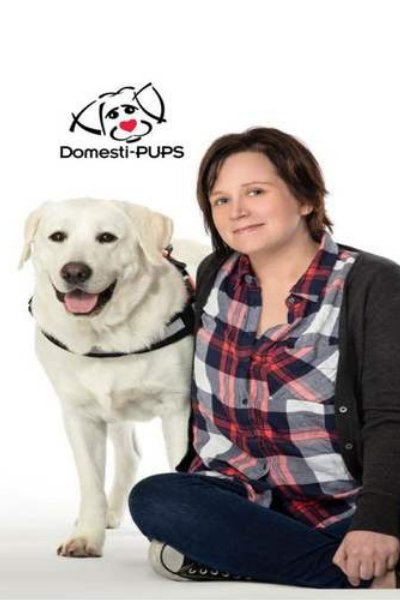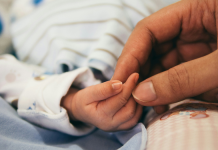Kids love dogs. Every time my little ones see a pup going by they immediately want to interact/pet/love on the ball of fluffy cuteness walking by. To be fair, I’m usually right there with them oohing and awing over the puppy strolling by. There is always the immediate mom response of,” Wait guys, ask the owner first” because I never know if the doggy is friendly or not, but then allow them to give the dog a pat if the answer is sure. This response became much different a few years back when a friend’s son got a service dog, and again as a reminder last year.
In October of 2018, my little sister was united with a service dog.
Diagnosed with Multiple Sclerosis in 2006, her mobility along with many other aspects of day to day living became greatly diminished and her need for assistance grew. Upon finding out that she was preparing to have a doggy assigned to her, it became apparent that I needed to talk with my kiddos about what to do when my sis and her dog were around.

So here it is: What every child should know about service dogs (or pets!)
- How do you know the difference between a pet and a service dog?
- Service dogs wear a special vest and there is typically some type of patch or wording that states they are a “service pet.” Showing our children pictures of what this may look like can help them know the difference between the two.
- Under no circumstance can you walk up and touch the dog, pet the dog, etc.
- This rule is probably the hardest for our babes. They see a cute pup (or another animal) and immediately want to go straight for it. While the doggy would love for this to occur, it distracts them from doing their job. Think of it like distracting a tight rope walker as they are halfway through. It could cause them to get spooked and fall.
- If you ask to pet the dog, the owner will say “sorry, no.”
- As hard as it is for the dog to not get a pat from you or your children, it is equally as hard for the owner. They don’t want to tell you no. They feel horrible, but know that it is necessary for the dog to stay focused on what they are trained to do. For my sister, this is the worst for her. She feels like people believe she is just being mean when she wants nothing more than to let you love on her doggy.
- Just because someone doesn’t “appear” as though they have a disability or a need for the dog doesn’t mean they don’t.
- There have been times with my sister that people have been ugly to her as she didn’t “look” disabled. Now that she is in a wheelchair/power chair when out and about it happens less, but for a long time, it wasn’t noticeable that anything was wrong. You couldn’t see that her eyesight had been affected and that she was struggling to see. Her gait was “normal” for a long time, but her stability was still affected by her feet and toes going numb which caused her foot to drag. Her pup can assist with her sight and her stability!
- These animals are AMAZING!
- They can detect high blood sugar in diabetics, seizures coming before they even start or even be used to locate children who are autistic and are prone to running off.
- The owner will NEVER mind you telling them how adorable their pup is.
My kiddos were so excited to learn something new. They wanted to know how to help and if they could “fundraise” for their aunt to get her dog. They enjoy telling their friends all about their Aunt Lori and her new dog Tucker. It was a conversation I never wanted to have as I obviously would never want my sister to need a dog for her day to day assistance, but at the same time, I’m glad I get to have these conversations with my children. They are often the first to run up to someone on the playground who is disabled and ask them to play. They have learned that disabilities don’t change the amazing person that lives with them. Most of all they have learned that needing help isn’t bad, different, weird or sad. We all need help every now and again, and that’s ok!













